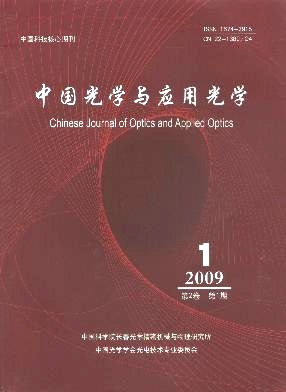2009 Vol. 2, No. 1
2009, 2(1): 1-9.
Abstract:
High resolution visible earth observation on the Geostationary Earth Orbit(GEO) has a series of unique advantages over that in the other orbits. However, long range and highresolution visible observation requests a large primary mirror more than 20 m in the diameter. The traditional Space Telescope(ST) with such a large primany mirror can not be launched to GEO, for its total mass is more than 1 000 t. An unsupported membrane ST and a large diameter diffraction ST can significantly reduce mirror surface density and lower down the total mass of the ST, which offers an excellent technologic approach to earth observation. Moreover, both the launching by module and the assembly in an orbit provide the technological means to tranport these kinds of observation systems from ground to GEO. Fourier telescope based on the theory of transform imaging changes the acquirement for highresolution from increasing the receiving diameter into ncreasing the illumination interval, and from detecting the object image directly into receiving the echo energy and reconstructing Fourier components. It breaks through the fatal bottleneck of the long range and hign resolution observation. Recently, a near perfect lens has been developed to provide the possibility for breakthrough of diffraction limit, so that a new science field will be set up for superresolution observation. The perfect lens makes of negative refractive index materials(lefthanded materials) and the negative refractive index materials come from both of the photonic crystals and the photonic devices based on Surface Plasmon Polariton(SPP).
High resolution visible earth observation on the Geostationary Earth Orbit(GEO) has a series of unique advantages over that in the other orbits. However, long range and highresolution visible observation requests a large primary mirror more than 20 m in the diameter. The traditional Space Telescope(ST) with such a large primany mirror can not be launched to GEO, for its total mass is more than 1 000 t. An unsupported membrane ST and a large diameter diffraction ST can significantly reduce mirror surface density and lower down the total mass of the ST, which offers an excellent technologic approach to earth observation. Moreover, both the launching by module and the assembly in an orbit provide the technological means to tranport these kinds of observation systems from ground to GEO. Fourier telescope based on the theory of transform imaging changes the acquirement for highresolution from increasing the receiving diameter into ncreasing the illumination interval, and from detecting the object image directly into receiving the echo energy and reconstructing Fourier components. It breaks through the fatal bottleneck of the long range and hign resolution observation. Recently, a near perfect lens has been developed to provide the possibility for breakthrough of diffraction limit, so that a new science field will be set up for superresolution observation. The perfect lens makes of negative refractive index materials(lefthanded materials) and the negative refractive index materials come from both of the photonic crystals and the photonic devices based on Surface Plasmon Polariton(SPP).
2009, 2(1): 10-16.
Abstract:
The present situation of advanced groundbased space target detecting systems at abroad are introduced in this paper. Then, two kinds of ground based optoelectronic tracking systems for detecting the space target, 35 m telescope and 367 m Advanced Electric Optical System(AEOS) telescope, are described and the working performance and working missions for two telescopes are given. On the basis of the design concept and advanced technological schemes reported above, the technologies relating to “ground based optoelectronic system for satellite imaging” are discussed. For the overall scheme of “large aperture ground based optoelectronic observation equipment for the satellite imaging”, the viewpoint to build a 18 m altazimuth telescope with adaptive optics technology is put forward, which suggests that the telescope is designed to be an optical table with expandable function.
The present situation of advanced groundbased space target detecting systems at abroad are introduced in this paper. Then, two kinds of ground based optoelectronic tracking systems for detecting the space target, 35 m telescope and 367 m Advanced Electric Optical System(AEOS) telescope, are described and the working performance and working missions for two telescopes are given. On the basis of the design concept and advanced technological schemes reported above, the technologies relating to “ground based optoelectronic system for satellite imaging” are discussed. For the overall scheme of “large aperture ground based optoelectronic observation equipment for the satellite imaging”, the viewpoint to build a 18 m altazimuth telescope with adaptive optics technology is put forward, which suggests that the telescope is designed to be an optical table with expandable function.
2009, 2(1): 17-22.
Abstract:
Space ultraviolet optical remote sensing is a preponderant field besides visible light, near infrared, thermal infrared and microwave remote sensing technologies. Now, research on change of global circumstances by space ultraviolet and vacuum ultraviolet optical remote sensing technique is a hot topic in the world. In this paper, the function, status and development of space ultraviolet optical remote sensing are reviewed, and the characteristics and performance parameters of several kinds of space UV remote sensing instruments are introduced. Finally, it indicates that the key points for UV remote sensing at present are applications of the space borne ultraviolet optical remote sensing instruments, accumulations of space detection data, and establishment of reversion algorithm. This paper suggests that the objectives of the UV optical remote sensing in future are to develop the instruments with nadir, limb and obscuration function synchronously, detect the threedimensional ozone in high accuracy, all weather and whole atmosphere, monitor the change and changing trend of atmospheric components in real time, and to expand the application scopes for space ultraviolet remote sensing instruments.
Space ultraviolet optical remote sensing is a preponderant field besides visible light, near infrared, thermal infrared and microwave remote sensing technologies. Now, research on change of global circumstances by space ultraviolet and vacuum ultraviolet optical remote sensing technique is a hot topic in the world. In this paper, the function, status and development of space ultraviolet optical remote sensing are reviewed, and the characteristics and performance parameters of several kinds of space UV remote sensing instruments are introduced. Finally, it indicates that the key points for UV remote sensing at present are applications of the space borne ultraviolet optical remote sensing instruments, accumulations of space detection data, and establishment of reversion algorithm. This paper suggests that the objectives of the UV optical remote sensing in future are to develop the instruments with nadir, limb and obscuration function synchronously, detect the threedimensional ozone in high accuracy, all weather and whole atmosphere, monitor the change and changing trend of atmospheric components in real time, and to expand the application scopes for space ultraviolet remote sensing instruments.
2009, 2(1): 23-28.
Abstract:
The working principle and design structure of the Solar Irradiance Absolute Radiometers(SIARs) developed by our research group is introduced. The radiometer offers its two improvements in burying the electrical heater winding into the wall of the cavity to improve the equivalence of electrical and radiative heating and in using thermo electrical temperature sensor to replace the usual resistance temperature sensor. The SIARs took part in International Pyrheliometer Comparisons(IPC) twice, and calibrated data are coincident well with World Radiometric Reference(WRR). Two SIARs have been put on PhysikalischMeteorologisches Observatorium Davos/World Radiometric Center(PMOD/WRC) to observe the sun together with the instruments of World Standard Group(WSG) for six years, and they show stable performance and uncertainty within 0.2%. Moreover, a Solar Constant Monitor(SCM) composed of three wide field of view SIARs mounted on SZ3 spacecraft has been used to measure solar irradiance for five months, obtained data are coincident with those of ACRIM in 0.2%. From June 2008, a Solar Total Irradiance Monitor(STIM) made up of three SIARs has also begun to measure total solar irradiance on FY3 satellite for long term.
The working principle and design structure of the Solar Irradiance Absolute Radiometers(SIARs) developed by our research group is introduced. The radiometer offers its two improvements in burying the electrical heater winding into the wall of the cavity to improve the equivalence of electrical and radiative heating and in using thermo electrical temperature sensor to replace the usual resistance temperature sensor. The SIARs took part in International Pyrheliometer Comparisons(IPC) twice, and calibrated data are coincident well with World Radiometric Reference(WRR). Two SIARs have been put on PhysikalischMeteorologisches Observatorium Davos/World Radiometric Center(PMOD/WRC) to observe the sun together with the instruments of World Standard Group(WSG) for six years, and they show stable performance and uncertainty within 0.2%. Moreover, a Solar Constant Monitor(SCM) composed of three wide field of view SIARs mounted on SZ3 spacecraft has been used to measure solar irradiance for five months, obtained data are coincident with those of ACRIM in 0.2%. From June 2008, a Solar Total Irradiance Monitor(STIM) made up of three SIARs has also begun to measure total solar irradiance on FY3 satellite for long term.
2009, 2(1): 29-35.
Abstract:
On the basis of analysis of the deployment motion of satellite solar array, a whole satellite model was established by UG and was imported to MSC. ADAMS. Then, the deployment of solar array was simulated in ADAMS. A jointing structure consisting of revolute joints, torsion springs and closed cable loops was built in ADAMS/View. Moreover, the impacting process was simulated by contact functions, the closed cable loops was simulated by couplers, and the dynamics characteristic was emulated in ADAMS/Solver. After analysis on the simulation, the relations between deployment angles of linker and solar panels with time were obtained, and the movement of satellite′ attitude influenced by deployment motion was calculated. Analysis results indicate that the deployment process of solar array is 15 s. The deployment motion is stabilization and smoothness, and has a little effect on satellite attitude. These results reported here show that designed solar array is reasonable.
On the basis of analysis of the deployment motion of satellite solar array, a whole satellite model was established by UG and was imported to MSC. ADAMS. Then, the deployment of solar array was simulated in ADAMS. A jointing structure consisting of revolute joints, torsion springs and closed cable loops was built in ADAMS/View. Moreover, the impacting process was simulated by contact functions, the closed cable loops was simulated by couplers, and the dynamics characteristic was emulated in ADAMS/Solver. After analysis on the simulation, the relations between deployment angles of linker and solar panels with time were obtained, and the movement of satellite′ attitude influenced by deployment motion was calculated. Analysis results indicate that the deployment process of solar array is 15 s. The deployment motion is stabilization and smoothness, and has a little effect on satellite attitude. These results reported here show that designed solar array is reasonable.



 Abstract
Abstract PDF 306KB
PDF 306KB





